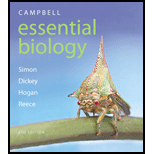
Campbell Essential Biology (6th Edition) - standalone book
6th Edition
ISBN: 9780133917789
Author: Eric J. Simon, Jean L. Dickey, Jane B. Reece, Kelly A. Hogan
Publisher: PEARSON
expand_more
expand_more
format_list_bulleted
Concept explainers
Textbook Question
Chapter 11, Problem 4SQ
A eukaryotic gene was inserted into the DNA of a bacterium the bacterium then transcribed this gene into mRNA and translated the mRNA into protein. The protein produced was useless and contained many more amino acids than the protein made by the eukaryotic cell Why?
- a. The mRNA was not spliced as it is in eukaryotes.
- b. Eukaryotes and prokaryotes use different genetic codes.
- c. Repressor proteins interfered with transcription and translation.
- d. Ribosomes were not able to bind to tRNA.
Expert Solution & Answer
Want to see the full answer?
Check out a sample textbook solution
Students have asked these similar questions
What words best describes this organism?
a. Unicellular/nonmotile
Ob. unicellular/motile
c. colonial/nonmotile
d. colonial/motile
e. multicelluar
O f. siphonous
g. none of these
Identify the phylum or class.
a. Euglenophyta
b. Dinoflagellata
c. Bacillariophyceae
d. Oomycetes
e. Phaeophyceae
O f. Myxomycota
g. Xanthophyceae
○ h. Chrysophyceae
i. Dictyosteliomycota
O j. Rhodophyta
Ok. Chlorophyceaens
I. Charophyceaens
What is produced inside the indicated structure (Fucus).
a. eggs
O b. antheridia
○ c. sperm
d. zygotes
e. none of these
Chapter 11 Solutions
Campbell Essential Biology (6th Edition) - standalone book
Ch. 11 - Your bore cells, muscle cells, and skin cells look...Ch. 11 - A group of prokaryotic genes with related...Ch. 11 - The regulation of gene expression must be more...Ch. 11 - A eukaryotic gene was inserted into the DNA of a...Ch. 11 - How does DNA packing in chromosomes prevent gene...Ch. 11 - What evidence demonstrates that differentiated...Ch. 11 - The most common procedure for cloning an animal is...Ch. 11 - Prob. 8SQCh. 11 - Prob. 9SQCh. 11 - Prob. 10SQ
Ch. 11 - What is the difference between oncogenes and...Ch. 11 - Prob. 12SQCh. 11 - Prob. 13PSCh. 11 - The human body has a far greater variety of...Ch. 11 - Because a cat must have both orange and non-orange...Ch. 11 - Design a DNA microarray experiment that measures...Ch. 11 - Prob. 17PSCh. 11 - Prob. 18BSCh. 11 - Prob. 19BS
Knowledge Booster
Learn more about
Need a deep-dive on the concept behind this application? Look no further. Learn more about this topic, biology and related others by exploring similar questions and additional content below.Similar questions
- Green Algae, as a group, is actually paraphyletic with one subgroup more closely related to higher plants than the other. Which of the following green algae groups is more closely related to higher plants: a. Charophyceans b. Chlorophyceans c. Rhodophyta d. Xanthophyceansarrow_forwardA single-celled green algal genus that is motile with 2 flagella, has a cup shaped chloroplast, and an eyespot: a. Volvox b. Chlamydomonas c. Euglena d. Codiumarrow_forwardA[n] ___ is produced by members of the Myxomycota when there is a lack of moisture. a. plasmodiocarp b. aethalium c. sclerotium d. plasmodiumarrow_forward
- Which of the following is not true about the life-cycle of Fucus. a. 8 eggs per oogonium b. 64 sperm per antheridium c. eggs are flagellated d. sperm are flagellatedarrow_forwardGreen Algae, as a group, is actually paraphyletic with one subgroup more closely related to higher plants than the other. Which of the following green algae groups is more closely related to higher plants: a. Charophyceans b. Chlorophyceans c. Rhodophyta d. Xanthophyceansarrow_forwardCertain toxic terpenoids in this group is thought to deter herbivory but may also have some anti-tumor activity? a. green algae b. brown algae c. red algae d. golden algae e. none of thesearrow_forward
- In the cellular slime molds, the most common phase is: a. plasmodium b. pseudoplasmodial c. single cells as myxamoebae d. moundingarrow_forwardWhich of the following descriptive terms does not describe Hydrodictyon? a. colonial b. nonmotile c. 1 large reticulated chloroplast in each cell d. all of these describe Hydrodictyonarrow_forwardWhich of the following does not apply to Chara? a. "stoneworts" b. isogamous c. calcified walls d. apical growth with an axis and branchesarrow_forward
arrow_back_ios
SEE MORE QUESTIONS
arrow_forward_ios
Recommended textbooks for you
 Concepts of BiologyBiologyISBN:9781938168116Author:Samantha Fowler, Rebecca Roush, James WisePublisher:OpenStax College
Concepts of BiologyBiologyISBN:9781938168116Author:Samantha Fowler, Rebecca Roush, James WisePublisher:OpenStax College
 Comprehensive Medical Assisting: Administrative a...NursingISBN:9781305964792Author:Wilburta Q. Lindh, Carol D. Tamparo, Barbara M. Dahl, Julie Morris, Cindy CorreaPublisher:Cengage Learning
Comprehensive Medical Assisting: Administrative a...NursingISBN:9781305964792Author:Wilburta Q. Lindh, Carol D. Tamparo, Barbara M. Dahl, Julie Morris, Cindy CorreaPublisher:Cengage Learning Human Heredity: Principles and Issues (MindTap Co...BiologyISBN:9781305251052Author:Michael CummingsPublisher:Cengage Learning
Human Heredity: Principles and Issues (MindTap Co...BiologyISBN:9781305251052Author:Michael CummingsPublisher:Cengage Learning Human Biology (MindTap Course List)BiologyISBN:9781305112100Author:Cecie Starr, Beverly McMillanPublisher:Cengage Learning
Human Biology (MindTap Course List)BiologyISBN:9781305112100Author:Cecie Starr, Beverly McMillanPublisher:Cengage Learning Biology Today and Tomorrow without Physiology (Mi...BiologyISBN:9781305117396Author:Cecie Starr, Christine Evers, Lisa StarrPublisher:Cengage Learning
Biology Today and Tomorrow without Physiology (Mi...BiologyISBN:9781305117396Author:Cecie Starr, Christine Evers, Lisa StarrPublisher:Cengage Learning

Concepts of Biology
Biology
ISBN:9781938168116
Author:Samantha Fowler, Rebecca Roush, James Wise
Publisher:OpenStax College


Comprehensive Medical Assisting: Administrative a...
Nursing
ISBN:9781305964792
Author:Wilburta Q. Lindh, Carol D. Tamparo, Barbara M. Dahl, Julie Morris, Cindy Correa
Publisher:Cengage Learning

Human Heredity: Principles and Issues (MindTap Co...
Biology
ISBN:9781305251052
Author:Michael Cummings
Publisher:Cengage Learning

Human Biology (MindTap Course List)
Biology
ISBN:9781305112100
Author:Cecie Starr, Beverly McMillan
Publisher:Cengage Learning

Biology Today and Tomorrow without Physiology (Mi...
Biology
ISBN:9781305117396
Author:Cecie Starr, Christine Evers, Lisa Starr
Publisher:Cengage Learning
Mitochondrial mutations; Author: Useful Genetics;https://www.youtube.com/watch?v=GvgXe-3RJeU;License: CC-BY